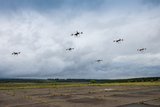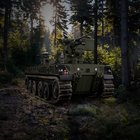Catapult launch rapidly becoming standard capability for high end tactical UAS
The continued evolution of advanced tactical class unmanned air systems (UAS) is showing a marked trend towards development of zero point launch as a capability standard according to Finnish unmanned air system launching specialist Robonic.
A two year development programme between Robonic of Finland and Selex Galileo to demonstrate a catapult launch capability for the Selex Falco UAS resulted in a successful demonstration at the Cheshnegirovo air base in Bulgaria on 11 December.
“This was the fourth time a Robonic launcher has been used to demonstrate zero point take-off as a capability enhancement to next generation tactical class UAS in the past three years” says Juha Moisio, Managing Director Robonic. “This is a new success story in the ongoing development of Robonic launchers. The depth of our cooperation with Selex Galileo again illustrates the critical need for close cooperation between air vehicle designers and UAS subsystem designers.”
Robonic launchers have been used by Sagem to demonstrate and then provide a mature zero point take off solution for both the Sagem Sperwer A and B series advanced tactical UAS. Robonic launchers were used to demonstrate the ability to carry out zero point take off for Elbit Hermes 450 UAS in April 2005.
“That four of the current tactical UAS reference programmes in the world today have turned to our solutions for zero point launch emphasises the importance of this capability in the maturation and evolution of systems able to support a simultaneous multi-intelligence capability.”
New generation advanced tactical UAS typically support increased endurance, carry a combination of sensor types able to be used simultaneously. The ability to provide inherent stores delivery capability is also now seen as essential to the capability mix supported by this class of air vehicle. “Those design elements point to a larger platform which has traditionally not been seen as appropriate to zero point launch” says Moisio.
“Our experience with Falco, the Sperwer programmes and Hermes 450 over the past three years clearly demonstrates that such new generation air vehicles can in fact continue to support high levels of tactical mobility in an operational theatre, this being shown through operations of first and second generation tactical UAS to be an important enabler in mission development and prosecution.
Moisio says that “this trend in air vehicle design has to be matched with appropriate suite engineering solutions if that operational flexibility is to be supported by current launcher technologies.
“We have achieved the launch of Falco, Hermes 450 and Sperwer B using the same model catapult and the development of appropriate interface kits, or adapters matching the requirements of each air vehicle type. The launch development process is by definition a complex and time consuming effort
“We have worked with BAE Systems to examine zero point launch for its Herti air vehicle using the same model catapult. Likewise we have conducted launch studies for the Denel Seeker II.
“Combined with our actual launch demonstrations, these two additional studies take our total evaluation record to seven medium to high end tactical UAS. That represents a substantial achievement by any terms” says Moisio.
Earlier models of the Robonic launch family are already used to launch RUAG Ranger tactical systems.
“Common lessons from each demonstration programme reinforce the likely emergence of a more flexible approach to the operational applications of advanced tactical UAS by contemporary defence forces, with zero point launch a key part of this.”
Moisio says that catapult launch had been a feature of second and early third generation tactical UAS but market trends moved away from this type of capability during the late 1990s and early 2000’s as air vehicle designers assessed that additional platform capability would necessitate runway dependent aircraft.
“It is clear that the anticipated direction of capability evolution has held true, but only for the larger classes of systems that we now understand as representing the medium altitude, long endurance (MALE) types. While high end tactical class systems have encroached on the MALE category in terms of endurance and multiple sensor capability, air vehicle design and continued enhancement of pneumatic launcher technologies have in fact allowed the zero point launch option to be retained.”
The trend towards zero point launch for tactical systems mirrors the widespread adoption of catapult systems for target drones, with Robonic already the dominant market supplier in that sector. Robonic has either studied launch options for or already actively launches nine of the worlds major target drone systems. These include the Northrop Grumman KDR, Avartek AT-4, FRL Falconet, Meggitt Banshee and Voodoo, and the EADS family of DT-25, DT-35, DT-45, and DT- 55.
Today, the catapult of Robonic is part of the tactical UAV Sperwer MK II system developed and marketed by Sagem.
More from Uncrewed Vehicles
-
![Ready for the race: Air separation drone swarms vs. air defence systems]()
Ready for the race: Air separation drone swarms vs. air defence systems
As the dynamics of aerial combat rapidly evolve, Chinese scientists have engineered a sophisticated air separation drone model that can fragment into up to six drones, each capable of executing distinct battlefield roles and challenging the efficacy of current anti-drone defences such as the UK’s Dragonfire laser system.
-
![Israel’s MALE UAVs ‘must adapt’ to Iranian-made air defences]()
Israel’s MALE UAVs ‘must adapt’ to Iranian-made air defences
Advancements in air defence technologies have begun to reshape aerial combat dynamics in the Middle East, as illustrated by recent events involving the Israeli Air Force and Hezbollah.
-
![Hundreds more UAS sent to Ukraine forces with thousands more on the way]()
Hundreds more UAS sent to Ukraine forces with thousands more on the way
Both sides of the Russia-Ukraine war have been using UAS for effective low-cost attacks, as well as impactful web and social media footage. Thousands more have now been committed to Ukrainian forces.
-
![AI and software companies selected for US Army Robotic Combat Vehicle subsystems]()
AI and software companies selected for US Army Robotic Combat Vehicle subsystems
The US Army has intentions to develop light, medium and heavy variants of the Robotic Combat Vehicle (RCV) as part of the branche’s Next Generation Combat Vehicle family.
-
![DroneShield to improve software of DroneSentry-X C-UAS system under new contract]()
DroneShield to improve software of DroneSentry-X C-UAS system under new contract
DroneSentry-X, a cross-vehicle compatible, automated 360° C-UAS detect and defeat device, can offer 360° awareness and protection using integrated sensors. According to its manufacturer, it is suitable for mobile operations, on-site surveillance and on-the-move missions.


























